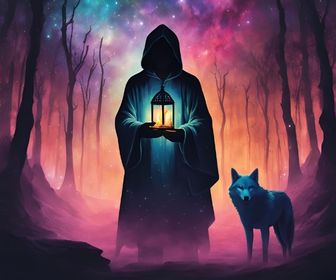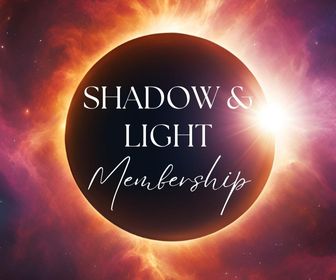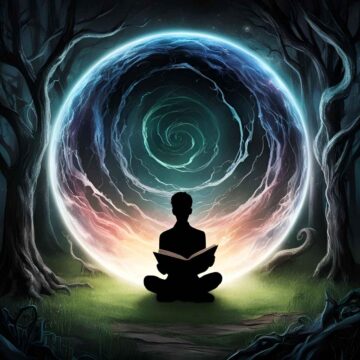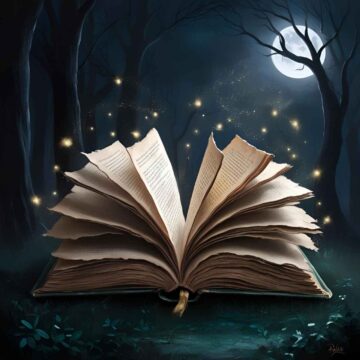What is Hypnagogia?
We all know that there are two primary states of consciousness: wakefulness and sleep. But did you that there is also an in-between state? This state is called Hypnagogia, a word that derives from the Greek words “hypnos” (sleep) and “agogos” (leading), meaning the state that leads into sleep.
Have you ever had a nap and experienced a strange trance-like state in which images, colors, sounds, even dream-like stories play out in your mind? Have you ever found yourself falling asleep and seeing a kaleidoscope of colors and shapes fleet in and out of your mind … or strange things like horses turning into helicopters? These experiences are hypnagogia in action and it’s likely that you experience hypnagogia multiple times a week, or even every day before you fall asleep!
So how can this unusual limbo state contribute to our self-understanding and spiritual growth? In this article, I’ll explain how.

Spiritual Wanderer Course:
Being a lone wolf and a spiritual wanderer is a sacred calling in life – a unique and alchemical path of awakening. You don’t need to feel lost, alone, or stuck on your journey any more. It’s time to meet your soul’s deep needs for clarity, self-acceptance, and empowerment. Let us show you how …
Table of contents
Types of Hypnagogia
Depending on whether you are primarily a visual (image-oriented), auditory (sound-oriented), or kinesthetic (physically-oriented) person (you can take a test here), your hypnogogic experience will vary.
Here are common ways hypnagogia is experienced:
- Images – e.g. monochromatic or colorful, static or moving, flat or three-dimensional – usually the images are fleeting but sometimes they form entire dream-like scenes
- Sounds – may be loud or quiet and involve hearing music, voices, snatches of conversation, rain, wind, white noise, repetitive words, having one’s name called, etc.
- Repetitive actions – known as the “Tetris effect,” when a person has spent a long time doing something repetitive (such as working, playing chess, exercising, reading) they may find themselves doing the same thing as they fall into the hypnagogic state
- Physical sensations – tastes, scents, textures, and sensations of coldness and heat may be experienced during hypnagogia, as well as feelings of floating, falling, leaving one’s body or having one’s body change shape
- Mental processes – at the edge of sleep thoughts begin to take a fluid and free-associative quality in which they morph and evolve in unusual, abstract, and innovative ways, uninfluenced by the ego
- Sleep paralysis – the temporary inability to move may, in some occurrences, accompany hypnagogia, however while this state may be alarming, it is harmless
It is also possible (and common) to experience multiple forms of hypnagogia. For example, you might visually enter a memory from the day that transforms before your eyes into an array of physical sensations and sounds. The combinations are limitless.
Spiritual Oneiromancy, Dali, and Dream Yoga

Throughout history, there have been many writers, artists, and philosophers who have used hypnagogia as a way of triggering new ideas, insights, and even inventions.
Artist Salvador Dali, writer Mary Shelley (author of Frankenstein), and inventor Thomas Edison are some of the most notable historical figures who have used hypnagogia to stimulate saucy new ideas. Both Dali and Edison, for example, used very similar techniques of sitting down with objects in their hands (a key for Dali and brass balls for Edison) and waking up once the object fell and hit the floor. This sudden awakening allowed them to quickly jolt out of their hypnagogic slumber and write down the thoughts and images that had been dancing through their minds.
In Tibetan Buddhism, hypnagogic states are used as a way of practicing “dream yoga.” Dream yoga is a form of spiritual practice that is based on the premise that dream-like states can be used to train the mind to enhance spiritual awareness. This self-discipline can contribute to the experience of enlightenment or self-realization.
In the modern age, there’s a niche of people who refer to themselves as Oneiromancers; or individuals who use dreams as a form of divination. The word Oneiromancy comes from the Greek ‘oneiros’ (dream) and ‘manteia’ (prophecy). Such people commonly use and interpret dreams as a way of prophesying the future.

Shadow & Light Membership:
⭐️⭐️⭐️⭐️⭐ "Straight from the very first weekly email, this has been mind-blowingly powerful, the synchronicity and the on-vibe contents resonate uncannily with my soul’s current challenges." – Marie
Even psychologists such as Carl Jung and Sigmund Freud have taken an intense interest in dreams and their potential meanings. Jung was notorious for his fascination with dreams and their connection with the unconscious mind since childhood.
I can’t personally vouch for the divination aspect of dreams (as in ‘oneiromancy,’ although I have had prophetic dreams). Furthermore, I believe that predicting the future is useless and a major distraction unless it is accompanied with work grounded in the present moment. That is why my approach to dreams and hypnagogia specifically is targeted towards psychological growth. Without understanding yourself, meeting your shadow self, uncovering and dealing with old traumas and wounds, and integrating what you find, you won’t get very far. All of the dream work in the world will be just that: a bunch of fantasy.
How to Use Hypnagogia to Explore Your Unconscious Mind
Hypnagogia is the shortest path for communication from our subconscious — Sirley Marques Bonham, physicist
In the secular world, hypnagogia is often used as a way of stimulating creativity. But I propose, similar to the Tibetan Buddhists and their ‘Dream Yoga’ and Carl Jung and his technique of ‘Active Imagination,’ that hypnagogia can be used for deep psychological discovery as well.
By seeking to find patterns, interpreting the images that arise, and coming in contact with the fragmented aspects of yourself, hypnagogia is a powerful form of self-exploration, and one with the potential of uniting you with your Soul’s Wholeness and ultimate purpose.
The unconscious mind is the part of our brain that contains everything we have buried away and forgotten: memories, defense mechanisms, wounds, ancestral traumas, archetypal forces or ‘sub-personalities’ – you name it.
In the trance-like state of hypnagogia we are able to observe our unconscious mind and its contents as it begins to bubble to the surface.
If you want to learn a simple and effective way of using hypnagogia to explore your unconscious, practice the one below:
1. Set an intention – ‘Prime’ your mind and get it ready before you go to sleep or have an afternoon nap. You can do this by constantly thinking about what it is you want to explore about 20-30 minutes before you go to rest. For example, your intention might be to find out why you struggle to have self-control around certain people, what mental belief is blocking your happiness, what your Shadow wants to tell you, or anything that is to do with you as a person. I find that it helps to be very clear about my intention and summarize it into a sentence. You can even write this sentence on a piece of paper if it helps. For example, your summarized intention might be “I want to understand why I always attract the wrong partners,” “I want to discover how to strengthen my social boundaries,” “I want to find out why I feel so unhappy and lost,” etc. Meditating on your intention is also a powerful way of priming your mind beforehand.
2. Find something to record your experience – Before you enter hypnagogia, find a notebook, journal, sketch pad, or voice activated recorder (there are mobile apps for that), and place it next to your bed/sofa/chair.
3. Set a gentle alarm – It takes on average about 10 to 20 minutes to fall asleep. So take a moment to consider how long it takes you on average to fall asleep. Do you go under quickly? In this case you might like to set the alarm on your phone or clock to 10 minutes. If you take a long time to fall asleep, experiment with setting your alarm to 20 minutes. With experience, and assessment of how tired you are beforehand, you’ll be able to skillfully adjust the alarm to the perfect amount of time that you need.
Would you like to save this?
Your information will never be shared.
4. Take a nap – Remember, your intention isn’t to fall asleep, (although if that happens, don’t worry, it can take practice!). Lie down on your bed, sofa, or whatever is comfortable, and relax. Let your body and mind drift off into a soft and hazy stupor. Completely unwind and let yourself be still.
5. Observe your mind – It is not always possible to clearly observe your mind, particularly when your consciousness is fading, which is why this step takes practice. You can use the sensation of your breath or chest rising and falling to help anchor yourself to awareness as you notice what is going on.
6. Time to record! – Bzzzz! At some point your alarm will go off. (Hopefully you set a gentle alarm, because loud obnoxious alarms can really be, well, alarming.) Once you’ve woken up, record what you have heard, seen, felt, or experienced. Do this quickly so that you don’t forget.
7. Interpretation – Reflect on what you have written, drawn or recorded. What are the first thoughts or feelings that pop into your mind? If you experience a strong physical/emotional ‘aha!’ reaction, you have found the right interpretation. Does your interpretation inspire, excite, or shock you? If so, it is probably correctly interpreted. According to Jungian analyst Robert A. Johnson, the best way to tell if you have interpreted dream imagery correctly is by the level of energy behind it. In other words, if your interpretation feels flat, dull, or lifeless, it is likely wrong. But if it feels alive and thrilling, you’ve likely found your answer.
Also, remember that hypnagogic imagery can be very abstract or very straight-forward – it is quite unpredictable. Sometimes it takes a while to interpret what you have experienced. Sometimes the material of your mind won’t be relevant to your question or intention. Keep practicing. Often images, words, sounds, and sensations may feel completely unrelated to your question. But when you revisit them a few days later, something may ‘click’ and you might suddenly discover how pertinent and symbolic they are.
8. Meditate on your discovery – After you have interpreted your hypnagogic content, sit and reflect on it. Meditate on its implications, lessons, and advice. I encourage you to journal about your experiences with hypnagogia as it will deepen your capacity to learn and grow from the practice. Learn more about how to journal.
***
Hypnagogia is a trippy, fascinating, kaleidoscopic world full of endless potential and possibility. Best of all, it provides an easy gateway to your unconscious mind. By taking advantage of this fleeting state of mind, you have the opportunity and ability to solve problems, gain guidance, and experience more inner peace and Wholeness.
Have you experimented with hypnagogic imagery before? Please share any tips or insights you have below!
If you need more help, we offer 3 powerful ways to guide you on your inner journey:
1. The Spiritual Wanderer Course: Feeling lost or uncertain about your path and purpose in life? Gain clarity and focus by learning about the five archetypes of awakening within you. Discover your deeper path and purpose using our in-depth psychospiritual map. Includes 3+ hours of audio-visual content, workbooks, meditations, and a premium test.
2. Shadow & Light Membership: Seeking ongoing support for your spiritual journey? Receive weekly intuitive guidance and learn to embrace your whole self, including your shadow side. Deepen your self-love and receive personal support from us.
3. Spiritual Awakening Bundle: Ready to soul search and dive deep? Access our complete "essentials" collection of beloved journals and eBooks. Includes five enlightening eBooks and seven guided journals, plus two special bonuses to further illuminate your path.







Each night since one year I have hypnagogic and hypnopompic visions of food. Sometimes associates with kinesthetic. Like someone I don’t see is feeding me. It’s awful…frightening. Thank you shitty reiki and tarot reading. I regret to have done such occult things. Since then, my life is a nightmare with those hypnagogic and hypnopompic visions.
I get this experience at the times you describe, but I also get that state when I am coming down from a headache.
I work as a delivery driver. I left the shop one day and started thinking about the Chinese elemental system wuxing and its relationships. I went into a sort of trance as described here. When I came to, I was slowing down below common residential speed to the end of a highway bypass.
I need to take my own advice and tread carefully, it seems.
What you explain is more like lucid dreaming, from what I have experienced this hypnotic state is much more difficult, it is a state where as u are about to nod of u are hit with a sudden whole body sensation of awareness of knowing u are separating, enough to jolt u from falling, it what I call the journey to an out of body experience, where one leaves the body in spirit, for most people the divide can be too much to bare, causing them to fight it, and miss out of the opportunity to experience this. There is always an inbetween, this is not like REM, you are there and then u are not like the flick of a switch, the sensation of this is your body telling you that you are about to leave, it could be a sudden noise, a quick image, or like what I have a body sensation from outside to inwards.
I definitely experience this during meditation a lot. I hear and see people doing things, like a short movie. I wrote everything down. Our minds are just amazing!
I expierence this all the time what is it?? Increased grey matter, acetycholine release, GABA? Is it adrenergic?
“Increased grey matter, acetycholine release, GABA? Is it adrenergic?” all these explains describe a brain chemical change; they don’t describe the subjective experience (and value) that can be found in hypnagogic states. I’d focus less on the ‘how’ and more on the ‘what’ there is to the experience. ~ M
Great timing! For five years I have been experiencing frequent eprisodes of what I have today learned is called hypnagogia. From early isolated episodes staring when I was 16 years and up to 2-3 times weekly of recent weeks. Usually between about anywhere from 12.30am to 3.30am. By 4am I can often fall asleep again, albeit very light sleep.
I have often stressed worrying that I might end up doing soe kind of damage to myself from severe sleep deprivation, as well as the intensity of the episodes. Today I realise that this occurence can actually be viewed as a portal to one’s inner Self, to the true self. The Self that Rumi and so many others talk about when they say the Universe is within each of us, we just have to ‘go within’. Hypnagogia is the portal to that consciousness of the within. This is also the path that shamans use in their inner travels and individuals of tribal communitites who are seeking a vision or an answer from Spirit. For me now that I have finally woken up to what it is, I see it as a doorway to a new world whgere I can find my wn answers and not rely on others.
Btw, this site was one for the first sites I refered to in 2017/18 when things started changing for me after my divine counterpart and I realised the depth and nature of our connection. I resist the term twin flme because it conjures up unrealistic 3D images of somethong that is way beyond 3D
You have been a big help to me over the recent years and I am grateful to you.
A few things you said resonate with me. 1. The time in which this takes place. 2. I have been seeking answers from spirit. 3. Doorway
Im not sure if you will get this message, but is your divine counter part a spiritual being? or a soul mate as in a human soul mate. Probably wrong terminology. I ask because i feel connected to a presence that seems to never leave my side. I feel connected to something that I can not explain. Not a bad energy type of vibe. I feel guided. I may sound nuts, but I swear I can see this cloud like kinda like smoke but very faint surrounding me. Sounds nuts anyways I digress. Just was interested in what you meant. (fyi i dont use drugs or drink alcohol at all! I go to bed at 10 pm every night and wake up at 6:30am to go to work). But man the sleep disturbances are real!! some times scary, sometimes helpful.
For example; what I experience is when I am starting to wake up I recently saw a shadow of a person standing in my door way and turning to walk away. again not a bad vibe. I thought it was my room mate at first.
One early morning around 1:30 probably. I thought I saw my closet door opening. I asked could you please close the door it started to close. My eyes adjusted more and then my heart started to beat fast and then this mocking ladys voice said oh she’s scared, When I fully woke up a few hours later I was confused was I dreaming or did that happen. Ill never know. its just that im like in this half awake half asleep state very eerie to say the least.
I have had questions asked to me but when I fully wake up the voice fads. The voice sounds outside of me and not a dream. I wake up startled because I think someone is in the room. I have started meditating and since then my dreams have become lucid and vivid. I have sleep paralysis, but I know what to do, so that doesnt bother me anymore. I know I am getting visited in my dreams because I asked for permission to wake up and poof i was finally able to wake up. I did end up finding my younger self who had been lost. so that ones a given. like I said sometimes helpful. Anyway, I was looking for a science explanation and stumbled on this topic. Says visual, audio hallucinations. I dont think its a crazy issue because it only happens when I am coming out of sleep.
Any insight that may help me understand what I am experiencing would be greatly appreciated.
Thanks
This is very helpful I did not know it had a name. I have been working on trauma trying to connect with my inner fragments that hold the trauma.I came looking for information because it’s getting interesting. I ask to meet them (intention) go into my pre sleep state. I sometimes still see the colors but last few times I see still pictures of people. They are sepia not smiling like Victorian photos. I don’t count them because I don’t want to break mood. There are maybe 15 women and then 10 men. Like a flip book?one appears over the last one. I am open to opinions or advice or shared experiences.
Hi i am looking for some help with a difficult spiritual awakening i am having. I have so much fear coming up and i have been doing so much work but i feel like sometimes im not sure if i will ever heal this fear inside me. Im just looking for some incouragement maybe. I was reading your articles and i feel like this is a good place to maybe ask for help. I have been having anxious visions when in the hypnogogic state and i get extreme fear but reading this helps me understand a little better what is going on. I thought i was going crazy and that is so scary.
With practice iv been able to go from black and white imagery to a full matrix like simulation im starting to think it might be the afterlife or something it gets really real if you keep going back there.. I dont know if its for everyone but im glad im able to experience it although some nights i will end up staying awake if it gets too much.. We are capable of so much more than we are told.. Look into the gateway method u can achieve it by teaching yourself no headphones are needed i found out about it years after teaching me and my friend how to do it.. Also kyrenzov mirrors are important i think.. All relates to non locality and quantum physics.. I was studying it 15yrs ago science said it was impossible back then but 2022 nobel prize proved non locality so it seems like science is finally catching up!
I have always experienced Hypnogogic Imagery …auditory and visual. Before I knew what it was called I had a funny experience with my bedside fan. Every morning I woke up to what seemed to be my neighbor’s radio playing everything from newscasts to talk shows and all kinds of music. I could follow very clearly what was being said or played especially lyrics. I was amazed at the eclectic musical taste of my neighbors. Opera, orchestral, piano solos, bluegrass, lots of advertising jingles and even kid’s music (they had a 3 year old so I thought nothing of it). None of this radio stuff was anything I had heard before which made me wonder which stations they were listening to.
Finally one morning as I was listening to “the radio”, I realized that as soon as I raised my head, the radio stopped. Now I am thinking there must be some sort of sound wave flux that only exists at the particular level of my pillow. Clearly I am no scientist. I asked my neighbor about the radio and she said they did not own one. After a lot of experimenting I realized that the “radio” came from the motor white sound of my fan. After reading about Lucid Dreaming at last I discovered that I was in a Hypnogogic state and it was all in my mind. Now I totally enjoy the “radio” and I can tune into it easily by focusing on that motor sound from the fan before going to sleep. Its always very entertaining.
Wow, this is amazing! The mind is a magical thing. To wake up to your own internally-generated music is awesome (it reminds me of the TV show Zoey’s Playlist).
Oh wow, I had a very similar experience! I live in an empty building at the last floor, with only 2 apartments on the last floor, (I am 100% sure the building is empty because I owned the building and we are doing works) and there is no other building next to mine from both sides. One night I could clearly hear voices which I believed was a TV, It startled me and woke me up I was worried that some of the workers might has stayed over night on the apartment in front of mine, when I went inside it was completely empty… Until today I had knew about the visual hypnagogia but had no idea of the auditory part, it all makes so much sense now !
I’ve experienced this my whole life, most nights, but feel unable to interpret the images. I see a large multi-limbed creature like a spider or octopus, floating above me or climbing up the wall, in various colours – these are fascinating! IF I move my eyes, or think about the image, they dissolve.
Other times I see figures standing by my bed, running through my bedroom or jumping off my wardrobe onto my bed – these make me scream and are more like night terrors! I thought they were just waking within a dream so I’m not sure how to interpret them for my self-development. Does anyone have any ideas?
yes u hav to learn to ‘look’ without using your eye muscles cos then it all goes dark as what you are seeing is not in the physical dimension.. If you get the hang of it eventually you can do everything just like a matrix style simulation, eating is very hard to simulate imo though and so are phones i often realise im not really awake when i type something 5 times and it comes out wrong:) look into the cia gateway method and kyrenzov mirrors we are capable of doing so so much when we sufficiently develop our conscious, this is why the system and war on drugs tries mentally trap us because the gov already know psychic and telepathic phenomena is achievable by anyone with free time and self belief